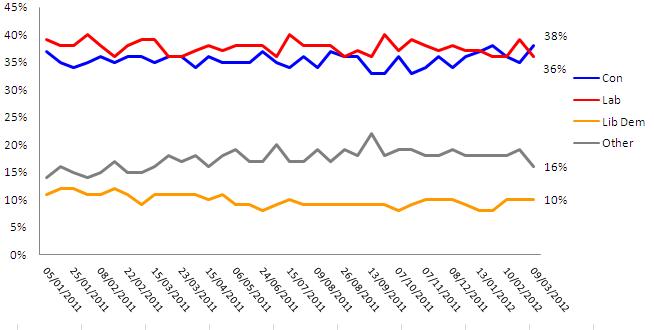Voting Intention – 9th March
9th March 2012
- The Conservatives are on 38%, just ahead of Labour on 36% with the Lib Dems unchanged at 10%.
- In the previous survey, Labour had a 4 point lead so it remains to be seen whether the previous poll was an outlier and whether this Tory lead is the beginning of a trend.
- Others are on 16%
- Prime Minister David Cameron’s approval rating remains broadly constant (-3% net approval compared to -5% two weeks ago)
- Labour leader Ed Miliband has seen his numbers dip slightly with a net approval rating of -28%, 2 points below his previous rating of -26%
- Lib Dem Leader Nick Clegg has seen a slight improvement on his record low of -42%. His approval figure has increased from 15% to 17% while his disapproval figure has dropped from 57% to 53% giving him a net rating of -36%
Topline Voting Intention
| † | % | Change |
| Conservative | 38 | +3 |
| Labour | 36 | -3 |
| Liberal Democrats | 10 | n/c |
| Other parties | 16 | -3 |
Other Parties (breakdown)
| † | % | Change |
| UKIP | 7 | +1 |
| Green | 3 | -2 |
| SNP | 3 | -1 |
| BNP | 2 | +1 |
| Plaid Cymru | 0 | -1 |
| Other | 1 | +1 |
Approval ratings
| † | % Approve | % Disapprove | Net rating | Net rating (own party) |
| David Cameron | 40% | 43% | -3% | +82% |
| Ed Miliband | 18% | 46% | -28% | +14% |
| Nick Clegg | 17% | 53% | -36% | +30% |

Opinium Research carried out an online survey of 1,955 GB adults aged 18+ from 9th to 12th March 2012. Results have been weighted to nationally representative criteria.
Interview Method and Sample
This survey is conducted online by CAWI (computer aided web interviewing), using Opinium?s online research panel of circa 30,000 individuals. This research is run from a representative sample of GB adults (aged 18+ in England, Scotland and Wales). The sample is scientifically defined from pre-collected registration data containing gender, age (18-34, 35-54, and 55+), region (North East, North West, Yorkshire and Humberside, East Midlands, West Midlands, East of England, London, South East, South West, Wales, and Scotland), working status and social grade to match the latest published ONS figures.
Opinium also takes into account differential response rates from the different demographic groups, to ensure the sample is representative.



